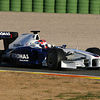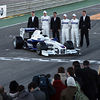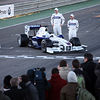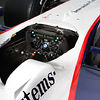BMW Sauber F1.09
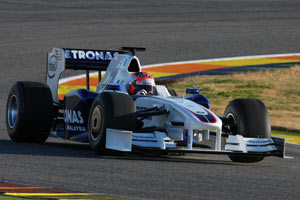
Active: 2009
Team: BMW Sauber F1
Drivers: Robert Kubica (5), Nick Heidfeld (6)
Team: Mario Theissen (BMW Motorsport director), Walter Riedl (Managing Director), Willy Rampf (Technical coordinator), Markus Duesmann (HP), Christoph Zimmermann (CD), Williams Toet (HA), Beat Zehnder (TM)
As 2009 sees arguably the most significant rewrite of the F1 technical rulebook in the history of the sport, the BMW Sauber F1.09 is practically a clean sheet design. Completely redefined aerodynamics, the return of slicks and the option of fitting KERS (Kinetic Energy Recovery System) technology have literally brought the teams back to the drawing board.
During the course of 2007, the OWG (Overtaking Working Group) set out a plan to ease overtaking and decided that the best way to do this was reduce downforce. In order to have an acceptable overtaking difficulty, a car's total downforce had to be reduced by 40%. As a result, the front wing has grown in width from 1400 mm to 1800 mm, making it as broad as the car as a whole. Conversely, the rear wing's width was reduced to 750 mm and its maximum height increased.
For Willy Rampf, the man responsible for the car's concept, and Walter Riedl, responsible for the development of the new car, this project has represented a memorable challenge. “Developing a new Formula One car is always exciting, but this time there was something even more special about it. We really were starting from scratch,” says Rampf.
The combination of the return of slicks with the possible use of KERS technology places particular importance on weight distribution. “First and foremost, the switch from grooved tyres to slicks means more grip, of course, but it also moves the balance of forces further forward: removing the grooves
gives the front tyres proportionally a greater contact area and more grip than the rear tyres,” explains Rampf. Consequently, more weight has to be shifted towards the front of the car and the aero balance adjusted likewise.
Compared to its competitors in the 2009 season, the BMW Sauber has fairly high sidepods that slope down towards the centre of the car. It is specifically shaped around the radiators to provide sufficient cooling for the engine, its ancilliaries and the KERS components. The sidepod still features small louvers close to the car's floor to form a hot air outlet, together with the rear end of the sidepod.
The nose and front wing are fairly similar to most other cars, except the the front wing's panels are held up with a fence, rather than a simple aluminium linkage.
Mechanically, the new car features a new front and rear suspension to make optimal use of the new slick tyres. Added to that, the gearbox casing - still produced in titanium - was revised but contains an almost identical internal component setup.
Rampf and Riedl further mentioned that they have put a lot of attention to the design of the front wing. The team carefully simulated several alternatives with its 'Albert3' supercomputer before deciding and optimising the best design. Because of the total reduction in downforce, they also admitted that the new car will run with maximum downforce at a lot more circuits than in 2008. When looking back on its initial development phase, most of the work appears to have gone into the aerodynamics, the optimisation of tyre usage and the integration of KERS.
Specifications
Chassis: carbon-fibre monocoque
Suspension: upper and lower wishbones (front and rear),
inboard springs and dampers, actuated by pushrods (Sachs Race Engineering)
Brakes: six-piston brake callipers (Brembo), carbon pads and discs (Brembo, Carbone Industrie)
Transmission: G1.09 7-speed 'quick-shift' gearbox designed to last 4 races, longitudinally mounted, carbon-fibre clutch
KERS: System with energy storage in batteries, BMW Sauber F1 Team
Chassis electronics: MES
Steering wheel: BMW Sauber F1 Team
Tyres: Bridgestone Potenza
Wheels: OZ
Dimensions
Length: 4690 mm
Width: 1800 mm
Height: 1000 mm
Track width, front: 1470 mm
Track width, rear: 1410 mm
Weight: 605 kg (incl. driver, tank empty)
Engine
Type: BMW P86/8, normally aspirated V8
Bank angle: 90 degrees
Displacement: 2,400 cc
Valves: four per cylinder
Valve train: pneumatic
Engine block: aluminium
Cylinder head: aluminium
Crankshaft: steel
Oil system: dry sump lubrication
Engine management: standard ECU (MES)
Spark plugs: NGK
Pistons: aluminium
Connecting rods: titanium
Dimensions:
- Length: 518 mm
- Width: 555 mm
- Height: 595 mm (overall)
Maximum engine speed: 18000 rpm

